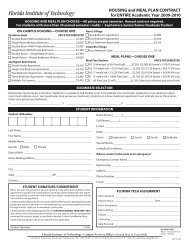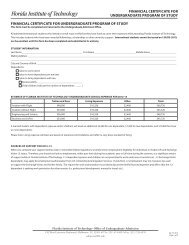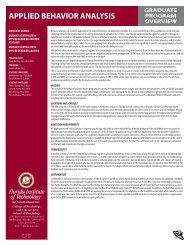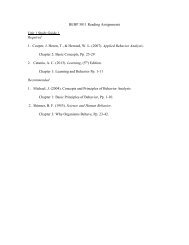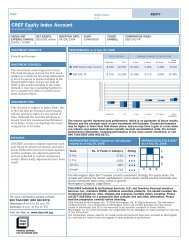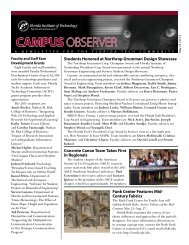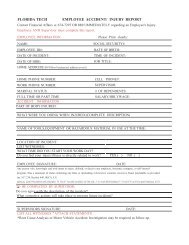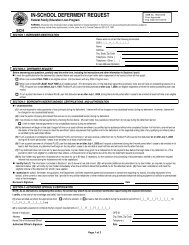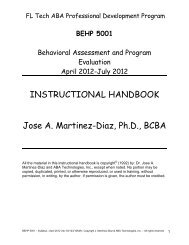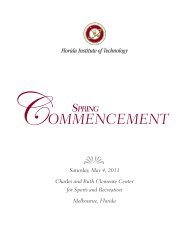2012–2013 UNIVERSITY CATALOG - Florida Institute of Technology
2012–2013 UNIVERSITY CATALOG - Florida Institute of Technology
2012–2013 UNIVERSITY CATALOG - Florida Institute of Technology
Create successful ePaper yourself
Turn your PDF publications into a flip-book with our unique Google optimized e-Paper software.
system dynamics and control, instrumentation and applied laser<br />
research, computer-aided design and computational research.<br />
Other laboratories around the campus can also be used by<br />
mechanical engineering graduate students performing advanced<br />
research.<br />
Funded research activities <strong>of</strong> mechanical and aerospace engineering<br />
faculty have recently included studies <strong>of</strong> efficient heat transfer/<br />
insulation mechanisms in building environments, advanced HVAC<br />
and fuel cell systems, integration <strong>of</strong> renewable energy sources into<br />
residential and utility applications, computation <strong>of</strong> radiative transport,<br />
computational mechanics with emphasis on nano-devices<br />
and damage mechanisms in laminated composite structures,<br />
development <strong>of</strong> experimental techniques for mechanical behavior<br />
<strong>of</strong> advanced materials systems, biomechanics, laser applications<br />
in bioengineering, turbulent boundary-layer structure, condition<br />
monitoring and fault diagnosis in rotating machinery and turbulent<br />
transport <strong>of</strong> moisture contained in air streams. Other studies have<br />
involved combustion in porous media, novel spatial and spherical<br />
mechanisms for part-orienting tasks, design and control <strong>of</strong> mobile<br />
robots, response <strong>of</strong> occupants in automobile collisions, smart<br />
composite structures with embedded sensors and optimization<br />
<strong>of</strong> composites. Research projects have been variously supported<br />
through grants from NASA, National Science Foundation, Defense<br />
Nuclear Agency, Air Force Office <strong>of</strong> Scientific Research, Edith<br />
Bush Charitable Foundation, <strong>Florida</strong> Solar Energy Center, <strong>Florida</strong><br />
Space Grant Consortium, Department <strong>of</strong> Energy and a number <strong>of</strong><br />
industrial affiliations.<br />
Laboratories include the Robotics and Spatial Systems Laboratory<br />
(RASSL); Laser, Optics and Instrumentation Laboratory (LOIL);<br />
Fluid Dynamics Laboratory and the Aerospace Structures<br />
Laboratory. RASSL is equipped with several industrial robots as<br />
well as a state-<strong>of</strong>-the-art autonomous mobile robot. In LOIL, the<br />
current technologies in continuous wave and short-pulse lasers<br />
and optics are used to develop new techniques for measuring and<br />
characterizing material properties for biomedical and material<br />
processing applications. The Fluid Dynamics Laboratory features<br />
a low-speed, low-turbulence wind tunnel <strong>of</strong> open-return type,<br />
with a square test section 0.535 m on a side and 1.6 m long. The<br />
speed range is from zero to 42 m/s. The mean turbulence level<br />
is a few hundredths <strong>of</strong> one percent at the lowest tunnel speeds.<br />
The Aerospace Structures Laboratory features a drop-tower for<br />
impact testing <strong>of</strong> structures and materials. This laboratory also<br />
has a shaker table for the vibration testing <strong>of</strong> structures. There are<br />
also ovens, vacuum pumps and other paraphernalia needed for the<br />
custom preparation <strong>of</strong> material specimens from advanced composite<br />
materials.<br />
The Human-Centered Design <strong>Institute</strong> (HCDI) members are<br />
faculty, permanent and visiting research scientists and graduate<br />
students conducting research in cognitive engineering, advanced<br />
interaction media, complexity analysis in human-centered design,<br />
life-critical systems, human-centered organization design and management,<br />
and modeling and simulation.<br />
See the Institution Overview section <strong>of</strong> this catalog for further<br />
information regarding the Dynamic Systems and Controls<br />
Laboratory; the Laser, Optics and Instrumentation Laboratory; and<br />
the Robotics and Spatial Systems Laboratory.<br />
hUmaN-CeNTereD DesigN iNsTiTUTe<br />
Guy A. Boy, Ph.D.<br />
Degree Program<br />
Human-Centered Design, Ph.D.<br />
Director and Program Chair<br />
Guy A. Boy, Ph.D.<br />
Adjunct Faculty<br />
J.M. Bradshaw, Ph.D.; M.M. Carvalho, Ph.D.;<br />
A.T. Duchowski, Ph.D.; T. Fong, Ph.D.; G. Grote, Ph.D.;<br />
R.J. Hansman Jr., Ph.D.; P. Millot, Ph.D.<br />
GRADUATE DEGREE PROGRAM<br />
Human-Centered Design, Ph.D. _________________<br />
major Code: 9200 Degree awarded: Doctor <strong>of</strong> Philosophy<br />
age restriction: N admission status: graduate<br />
Delivery mode/s: classroom only Location/s: main campus<br />
admission materials: 3 letters <strong>of</strong><br />
recommendation, résumé, objectives, GRE<br />
The Ph.D. program in human-centered design is designed to provide<br />
advanced education and research opportunities to qualified students<br />
with master’s degrees. On completion, the students can conduct<br />
independent scholarly work, teach in academia or pursue advanced<br />
research careers in government, or commercial or private sectors.<br />
Admission Requirements<br />
Admission to doctoral study is granted to qualified students on a<br />
limited basis who have successfully completed master’s degrees in<br />
engineering, physical or computer science, or mathematics from<br />
regionally accredited institutions. The program is ideally suited for<br />
applicants with strong interest in human and social science or the<br />
arts. Applicants with demonstrated background in industry and<br />
academia are eligible and prior experience is highly recommended.<br />
The applicant must have a master’s degree cumulative GPA <strong>of</strong> at<br />
least 3.2 on a 4.0 scale and a minimum score <strong>of</strong> 1100 on the GRE.<br />
International applicants must score 600 or higher on the TOEFL<br />
examination. Applicants must submit undergraduate and graduate<br />
transcripts, three letters <strong>of</strong> recommendation and a statement <strong>of</strong><br />
objectives in addition to the GRE and TOEFL scores.<br />
General admission requirements and the application process are<br />
covered in the Academic Overview section.<br />
Degree Requirements<br />
The Doctor <strong>of</strong> Philosophy in Human-Centered Design is conferred<br />
for successful completion <strong>of</strong> the coursework outlined below.<br />
General degree requirements are presented under the Academic<br />
Overview section.<br />
Coursework and Dissertation Summary<br />
Doctoral coursework minimum beyond the master’s degree................ 18–24<br />
Doctoral research and dissertation............................................................. 24<br />
TOTAL MINIMUM BEYOND THE MASTER’S DEGREE .............42–48<br />
Curriculum<br />
In addition to the 18 to 24 credit hours <strong>of</strong> coursework, the major<br />
adviser may require additional courses to better prepare the student<br />
to conduct research in the selected topic.<br />
The student must complete an approved program plan within one<br />
month <strong>of</strong> acceptance to the doctoral program, successfully pass a<br />
comprehensive examination, submit a dissertation proposal and<br />
defend that proposal to the dissertation committee. The candidate<br />
Degree Programs—College <strong>of</strong> Engineering 147



